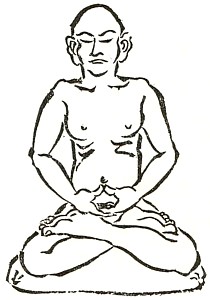Lotus in the fire
Positioning the hands |
|
First of all, here is a video about zazen by Alicia and Seigaku who visited us last spring. They now have their own dojo in Berlin. Here is their Facebook page:
http://www.facebook.com/undoinberlin. The video is perhaps the best I know on zazen. Check it out:
A person who runs a wellness studio asks a good question in the comments section:
"Why must it be left palm over the right palm in sitting meditation? What would happen if we were to do it right palm over the left? Thank u."
To this question, Seigaku answers:
"Basically, we do it that way because it's written in 普勧坐禅儀 (fukanzazengi) by Dogen. We regard keeping up a tradition as it is very important to Zen.
Also, from my experience, I feel the human body structure is asymmetrical. The tradition has a specific way for the body movements to accompany the working of nature. Why is a track field always counterclockwise? Surely, it can be made to run clockwise. You can feel a different flow of power when you change it."
Now, although I love the video and everything, I have my problems with this answer. Valueing tradition is fine of course, especially when you are living in a traditional Japanese monastery (and Seigaku was trained in Eiheiji, the most traditional monastery in all of Japan). But Seigaku seems to suggest that it is somehow natural for us human beings to place the left hand on top of the right hand during zazen. He is even talking about a "flow of power". But, as I explained in the November/December issue of 2008, I do not think that such a flow of power really exists. The left side is just as natural as the right side. Otherwise, why would Indian practioners or Buddhist monks from the Theravada tradition place the right hand on top? It should feel "un-natrual" for them, shouldn't it? Ironically, the reason for people from Southern Asia to place the right hand on top is the same as the one Seigaku gives for placing the left hand on top: Tradition! Of course, placing the left hand on top of the right hand somehow "feels different" from placing the right hand on top of the left hand. At least that is what I experienced after twenty years of placing the left hand on top of the right hand, before experimenting for the first time with the opposite, "Indian" style hand positon.

But then again, when you are used to driving on the left side of the road (as we do in Japan), driving on the right side somehow feels "un-natural". When I drove a car for the very first time in Germany about foour years ago (I took my driver's licence about 15 years ago in Japan - although I was born and raised in the country of the Autobahn, I never felt the urge to take the licence or sit behind a wheel before I became a monk at Antaiji and realized that without vehicles life here is all but impossible), it felt very, very awkward to be on the "wrong" side of the road. But then, after a couple of days, you do not notice any more. I have the same experience with the hands. If you put the left or the right hand on top does, in the long run, have no effect at all on the "inner experience" of meditation. There is a small physical difference though. I quote from the aforementioned November/December issue of 2008:
How about the hands then? For most, the issue of the hands will not be as urgent as that of the feet, as the hands usually do not hurt that much. If you are left-handed or right handed doesn't matter so much, you probably can sit with the left hand covering the right hand without much problems. I also sat with my left hand up for more than 20 years without even thinking about trying the other way. Only when I was wondering if there might be any physical evidence to the yin/yang side interpretation did I start to experiment with sitting the other way around, holding my right hand above my left hand. I thought: Maybe it is really true that my right, guiding, dominant hand, being connected to my left brain, is more yang. By covering it with my left hand during zazen, maybe I become more "yin" tempered. But how about in the winter? There are times when the temperatures in the meditation hall fall down to freezing point, and after an hour you lose the feeling in the hand that is up (i.e. the left hand). Shouldn't that mean that my right (yin) brain gets paralyzed and I am all yang now? What if I switched the hands and warm my left hand up, while the right hand is in the cold?
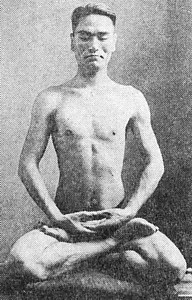 | What I realized was, that it really made a difference during breakfast after two hours of zazen: If both hands had stayed out in the cold for about the same amount of time, I could still open and handle the eating bowls properly. If only one hand was out all the time, on a cold morning that hand would be completely numb and holding my bowls was not so easy. But apart from that, I did not feel more "yin" or "yang" depending on which side was up. I found though, that it helped my shoulders to switch hands, just as it helped my pelvis to switch feet. Although the hands themselves don't hurt, always having the same hand one centimeter higher than the other can make a difference for the shoulders on the long run.
On the left you see a picture of a young Deshimaru. He is sitting with his right foot over the left foot, but with his left hand covering the right hand. Although Deshimaru had the reputation of having an excellent physical posture, it is obvious that his hands are not straight, but that the left wrist is held higher than the right. The left shoulder is also held higher than the right shoulder, which seems more relaxed. This is caused by the fact that the right foot, resting on the left thigh and supporting the left hand, ends up sitting higher than the left foot below it. This would probably be the same with pretty much anyone who is sitting: The hand that is placed on the foot that is "up" will be higher than the other hand. I therefore think that Deshimaru is right in placing the hands in the opposite way than he places the feet. If he was wearing his robes he would need just a little more support of the sleeves under his right hand. Some teachers recommend that you just follow Dogen and always sit with your left hand up. Others say that if your right foot is up, you should also have your right hand up, and the other way around. It is true that if your right foot is up, it supports your left hand, which in turn supports the right hand. Still, I do not think that this "right foot up=right hand up/left foot up=left hand up" posture is a good idea, because then the weight of both hands rests on only one wrist that is supported by only one foot. If you place the lower hand in the cavity that is created by the lower foot, and than the higher hand on top of the higher foot (as Deshimaru does in the picture), the weight is distributed much more even. |
Place your right hand on your left leg and your left hand on your right palm, thumb-tips lightly touching, Dogen says in the Fukanzazengi, but actually that is easier said than done.
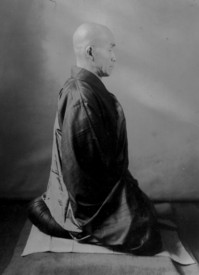
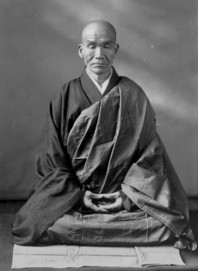

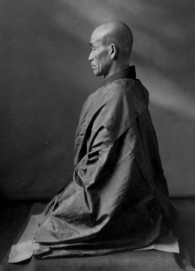


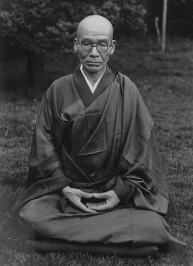
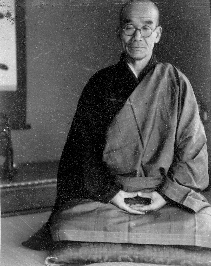
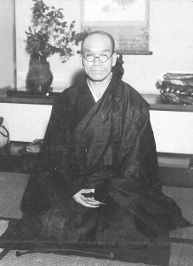
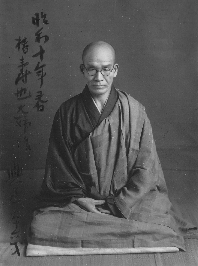

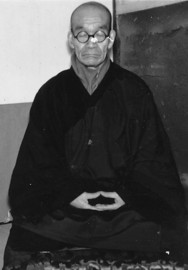


















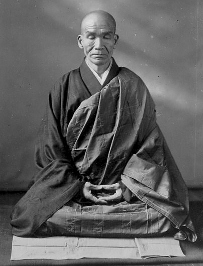







Another point that might be worth mentioning is the exact positon of the thumbs in relation to the navel. The Shobogenzo Zazengi goes into a little more detail than the Fukanzazengi quote we saw above. Here is the Zazengi: Place your right hand on your left foot. And your left hand on your right hand palm. The tips of your thumbs should be lightly touching. Position both your hands as above, and put them close to your body. The tips of your thumbs should be aligned with your navel.
The question is: How close should the thumbs be to the body, and what exactly does it mean that the thumbs should be "aligned" with the navel?




Today, when I sit in zazen, I do not worry so much about the exact position of the thumbs anymore. As you can see from the enlarged pictures above, even Sawaki Roshi's thumbs changed position over the years.
On the other hand, concentrating on and working with the exact position of the thumbs can be a good technique when you have trouble to stay focused or even awake during zazen. It is the same as with concentrating on the breath or focusing the eyes on one point during zazen (I will come back to that in a later article):
Normally, you do not have to do that. Just sit and let go. Be open to the 360 degerees of your awareness. Let the whole landscape of zazen in, without trying to touch or change any one thing.
But: That is not so easy, especially in the beginning. Lots of people have trouble staying grounded in a stable position of body and mind. Re-adjusting the physical posture can help. Putting the mind in one spot can help as well. Keizan Zenji, in his Zazenyojinki, mentions the feet, the navel, the left hand, the top of the scull and the tip of the nose as examples of physical spots were one can put the mind to readjust one's body-mind condition.
As a rule of thumb: The higher you place the mind, the more awake you become. You become more agitated, which can also lead to nervousness and more thinking. Placing the mind in a lower postion helps to cool down, relax, get grounded. On the other hand, you might become dull, sleepy, unfocused.
Now, in my experience working with the thumbs has the same effect. When you put them in a way so that their tips touch your navel (this is easy to do when you wear monks' robes, otherwise you can place a folded towel under the hands), first you can be sure that the thumbs are positioned in the exact center. Second, your mind will also become centered, as long as it stays with the thumbs. Third, you will realize when ever you were unconcentrated or slept during zazen. Actually, this is harder to realize than most people think. Because when you are asleep, you usually are not aware that you are asleep. And when you return from your nap, most people think they were "in samadhi" or whatever, they do not realize they just were not aware.
What happens with the tumbs when you sleep? They do not touch the navel anymore. So whenever your mind returns to the thumbs and realizes that they have not stayed with the navel, it is a clear sign that you were unconcentrated, propably even sleeping. When did the thumbs move? How did it happen? Find out!
So once more, working with the thumbs helps three things: Staying physically centered, staying mentally centered and staying awake.
What could be a problem of concentrating on the thumbs? As said above, the aim of zazen is just sitting, is just letting go. Being open to everything. When you concentrate on the thumbs though, and only on the thumbs, it might help you with problems that you are encountering at the time during your practice (and therefore I have recommended it to some people), but in the long run, you should try to open up to the whole body-mind experience, including the whole posture, every breath, the whole field of vision, everything you hear, the smells, the flavour on your tongue, even the random thoughts you wish to supress.
So much for today.
[Muho]
| <<< Previous article | Contents | Next article >>> |


